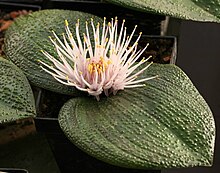
Scilla is a genus of about 30 to 80 species of bulb-forming perennial herbaceous plants in the family Asparagaceae, subfamily Scilloideae. Sometimes called the squills in English, they are native to woodlands, subalpine meadows, and seashores throughout Europe, Africa and the Middle East. A few species are also naturalized in Australasia and North America. Their flowers are usually blue, but white, pink, and purple types are known; most flower in early spring, but a few are autumn-flowering. Several Scilla species are valued as ornamental garden plants.

Scilloideae is a subfamily of bulbous plants within the family Asparagaceae. Scilloideae is sometimes treated as a separate family Hyacinthaceae, named after the genus Hyacinthus. Scilloideae or Hyacinthaceae include many familiar garden plants such as Hyacinthus (hyacinths), Hyacinthoides (bluebells), Muscari and Scilla and Puschkinia. Some are important as cut flowers.

Ornithogalum is a genus of perennial plants mostly native to southern Europe and southern Africa belonging to the family Asparagaceae. Some species are native to other areas such as the Caucasus. Growing from a bulb, species have linear basal leaves and a slender stalk, up to 30 cm tall, bearing clusters of typically white star-shaped flowers, often striped with green. The common name of the genus, star-of-Bethlehem, is based on its star-shaped flowers, after the Star of Bethlehem that appears in the biblical account of the birth of Jesus. The number of species has varied considerably, depending on authority, from 50 to 300.
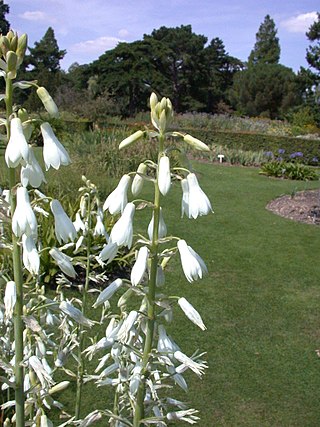
Galtonia is a genus of plants in the family Asparagaceae, subfamily Scilloideae. Native to Southern Africa, the genus is named after Sir Francis Galton. According to some authorities it has been subsumed into Ornithogalum as a subgenus, while others prefer to keep it as a separate genus.
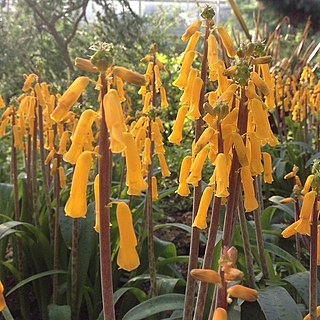
Lachenalia is a genus of bulbous perennial plants in the family Asparagaceae, subfamily Scilloideae, which are usually found in Namibia and South Africa. Most of them have a dormancy period, but new roots will always grow every year.
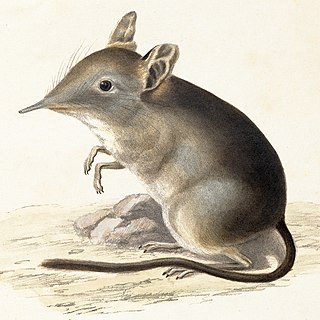
The Cape elephant shrew, also known as the Cape rock elephant-shrew or Cape rock sengi, is a species of elephant shrew in the family Macroscelididae. It is endemic to South Africa, although it is a relatively common animal. Its natural habitat is rocky areas. Elephant shrews are not closely related to other species of shrews and to rodents such as mice. E. edwardii has been observed to be a non-flying mammal pollinator of the pagoda lily. Elephant shrews are floral pollinators due to their largely insectivorous diet. Elephant-shrews are pollinators of Hyobanche atropurpurea. It uses its long slender tongue to feed on the pagoda lily's nectar while getting the lily's pollen on its long nose. E. edwardii is also a pollinator of Protea sulphurea.
Massonia etesionamibensis is a species of plant that is endemic to Namibia. Its natural habitat is rocky areas. The genus is named for Scottish botanist and gardener Francis Masson.
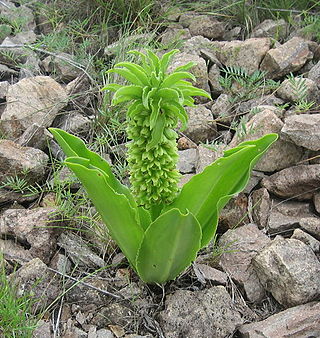
Eucomis is a genus of flowering plants in the family Asparagaceae, subfamily Scilloideae, native to southern Africa. Most species of this genus are commonly referred to as pineapple flowers or pineapple lilies. They are bulbous perennials with basal rosettes of leaves and stout stems covered in star-shaped flowers with a tuft of green bracts at the top, superficially resembling a pineapple – hence the common names.

Albuca is a genus of flowering plants in the family Asparagaceae, subfamily Scilloideae. The genus is distributed mainly in southern and eastern Africa, with some species occurring in northern Africa and the Arabian Peninsula. Plants of the genus are known commonly as slime lilies.

Drimia is a genus of African, south European and south Asian flowering plants. In the APG IV classification system, it is placed in the family Asparagaceae, subfamily Scilloideae. When broadly circumscribed, the genus includes a number of other genera previously treated separately, including Litanthus, Rhodocodon, Schizobasis and Urginea.

Daubenya is a genus of bulbous flowering plants in the family Asparagaceae, subfamily Scilloideae. It is native to the Cape Province of South Africa. At first believed to consist of a single species, Daubenya aurea, the genus was expanded in 2000 to include the genera Androsiphonand Amphisiphon and various species that had previously been classified as Polyxena, Massonia, or Neobakeria. "The poor congruence between morphological and other characters within Hyacinthaceae has also made generic circumscriptions very difficult. One of the consequences of this has been the recognition of a large number of genera that are poorly defined morphologically."-

Fusifilum is a genus of bulbous flowering plants in the family Asparagaceae, subfamily Scilloideae. It is distributed in southern Africa. Some sources consider that all the species should be placed in the genus Drimia.
Namophila is a monotypic genus of bulbous flowering plants in the family Asparagaceae, subfamily Scilloideae. The sole species Namophila urotepala is endemic to Namibia.
Ute Müller-Doblies is a German botanist with an interest in the systematics of Amaryllidaceae. She is currently at the Herbarium of the Technische Universität Berlin in collaboration with Dietrich Müller-Doblies (D.Müll.-Doblies.).
Zingela is a genus of flowering plant in the family Asparagaceae. It has only one currently accepted species, Zingela pooleyorum, native to KwaZulu-Natal in South Africa. It was previously misidentified as specimens of Drimia indica.
Austronea is a genus of flowering plants in the family Asparagaceae, found in Namibia and South Africa. It is sister to Fusifilum.
Massonia triflora is a species of flowering plant in the family Asparagaceae, native to the western Cape Provinces of South Africa. As its synonym Massonia citrina it has gained the Royal Horticultural Society's Award of Garden Merit as an ornamental. Some authorities consider it to be a synonym of Massonia depressa, the hedgehog lily.
